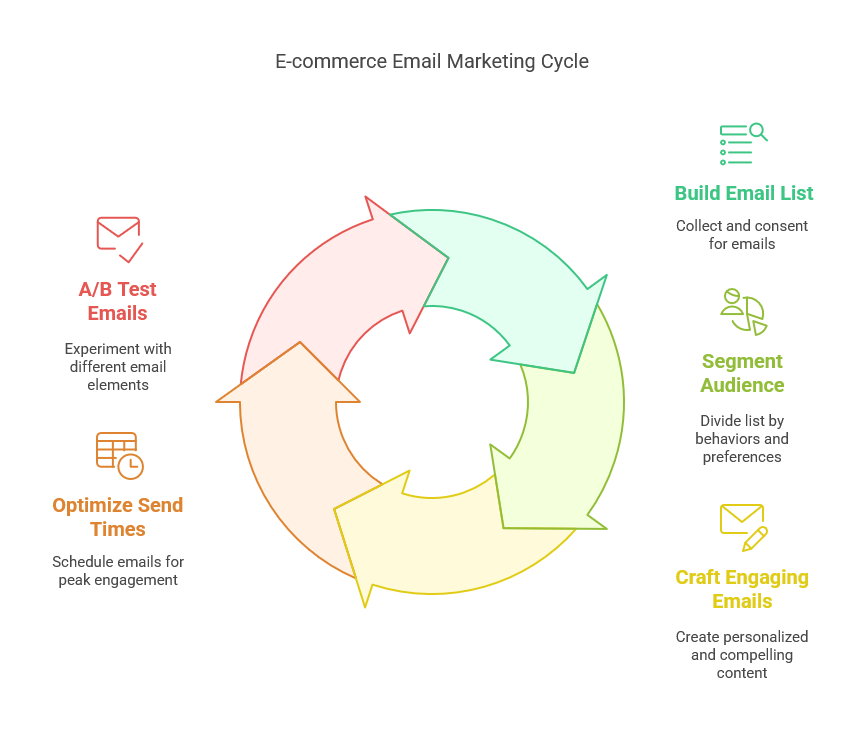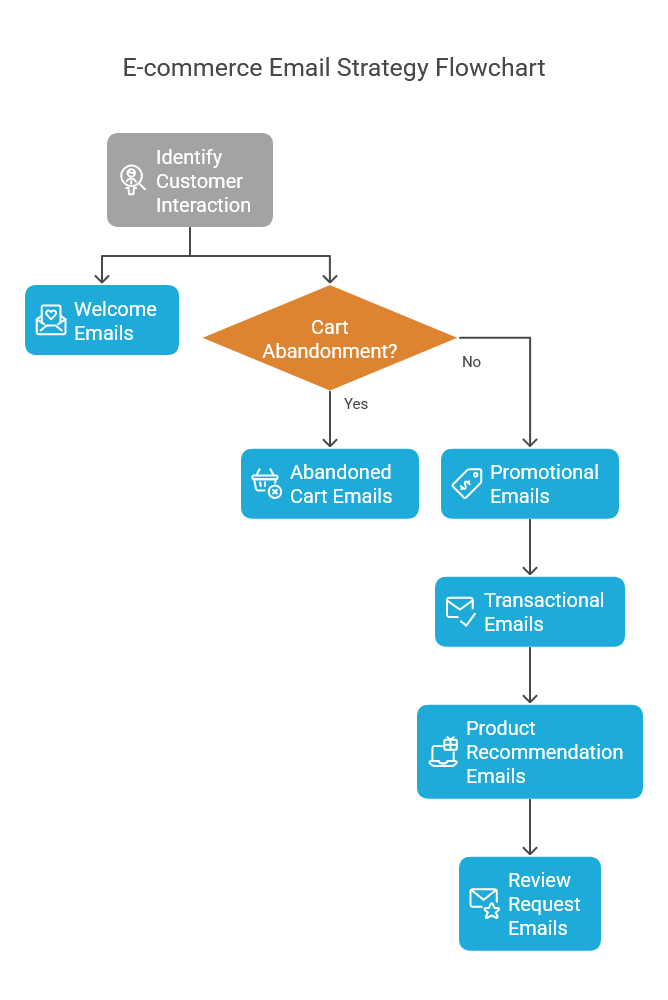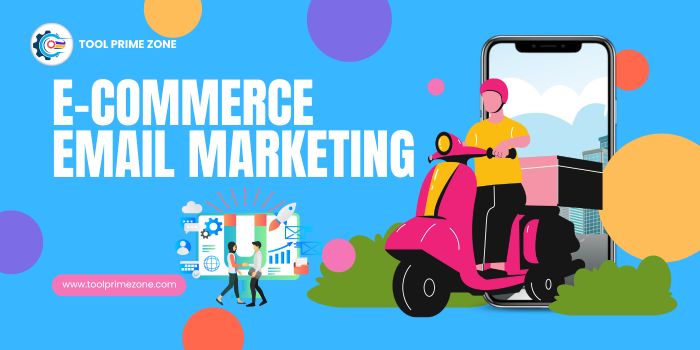E-commerce email marketing is crucial for building strong relationships with your customers. According to a report by Statista, 89% of marketers use email as their primary channel for lead generation, showing its effectiveness. Unlike social media or SEO, emails allow businesses to communicate directly with their target audience more personally.
With the right strategy, e-commerce email marketing helps you stay connected with your customers. You can send personalized offers, reminders, and product recommendations. This builds customer trust and loyalty, leading to increased sales.
According to a 2023 study, email marketing generates $42 for every $1 spent, making it one of the most cost-effective marketing channels for e-commerce businesses.
How to Build an Effective E-commerce Email Marketing Strategy
1. Build a Quality Email List
The first step to any successful email marketing campaign is having a clean and accurate email list. Collect email addresses from your website, social media channels, and other platforms. Be sure to ask for consent before sending any marketing material. Sending unsolicited emails can hurt your reputation and harm your business.
2. Segment Your Audience
Not all customers are the same. Segment your email list based on customer behaviors, preferences, and demographics. For example, you can have separate email lists for first-time customers, repeat buyers, and customers who haven’t purchased in a while. By sending targeted messages to specific groups, you increase the chances of converting leads into loyal customers.
3. Craft Engaging Emails
Your emails must grab attention quickly. Use compelling subject lines, simple language, and clear calls-to-action (CTAs). A good email should have the following components:
-
A catchy subject line: This is the first thing your audience sees. Make it engaging to increase the open rate.
-
Personalized content: Personalization increases the chances of engagement. Use the recipient’s name and recommend products based on their previous purchases.
-
Clear call-to-action (CTA): Ensure the recipient knows what action to take next. Use buttons like “Shop Now” or “Get 20% Off.”
4. Send the Right Emails at the Right Time
Timing matters in email marketing. Send emails when your audience is most likely to open them. For example, sending emails in the evening when people are winding down might work best if you sell fashion. Test different times and track open rates to find the best time for your audience.
5. A/B Test Your Emails
A/B testing helps you determine what works best for your audience. Test different subject lines, email designs, and CTAs. This will help you understand which email elements are most effective in driving engagement.

Types of E-commerce Emails You Should Send
There are several types of emails you can send to your customers. Each type serves a different purpose and helps you move prospects further down the sales funnel.
1. Welcome Emails
A welcome email is the first email a new subscriber receives. It should introduce your brand and what customers can expect from your emails. Welcome emails have high open rates, making them an excellent opportunity to make a good first impression.
2. Abandoned Cart Emails
Abandoned cart emails are sent to customers who add items to their cart but leave your site without completing the purchase. These emails are highly effective, with one study showing that abandoned cart emails have an average open rate of 45%. Remind your customers about the items they left behind and offer incentives like discounts or free shipping to encourage them to complete the purchase.
3. Promotional Emails
Promotional emails inform customers about sales, discounts, and special offers. These emails are great for driving conversions during seasonal events or clearance sales.
4. Transactional Emails
Transactional emails include order confirmations, shipping notifications, and receipts. While these emails are necessary for your business, they allow you to engage with customers. Consider adding upsell or cross-sell suggestions within these emails to boost revenue.
5. Product Recommendation Emails
Product recommendation emails are personalized messages that suggest items based on past purchases or browsing history. These emails are a great way to encourage repeat purchases and increase average order value.
6. Review Request Emails
After a customer makes a purchase, email them asking for feedback. Positive reviews help build trust with new customers and improve your online reputation. You can also offer incentives like discounts or loyalty points in exchange for reviews.

Tips for Improving Your E-commerce Email Marketing Results
-
Optimize for Mobile: Many people check their emails on mobile devices. Using responsive designs ensures your emails are mobile-friendly.
-
Use Simple Language: Keep your content clear and to the point. Avoid jargon or overly complex words.
-
Include High-Quality Images: Show your products in the best light by including high-quality images in your emails.
-
Provide Value: Always give your subscribers something of value, whether it’s a special offer or helpful information.
-
Monitor Metrics: Track metrics like open rates, click-through rates, and conversions to measure the success of your campaigns. This will help you refine your strategies over time.
Best E-commerce Email Marketing Tools
There are several tools available that can help you manage and optimize your email marketing campaigns. Some popular options include:
-
Mailchimp: Known for its ease of use and automation features, Mailchimp is a popular choice for e-commerce email marketing.
-
Klaviyo: Klaviyo specializes in e-commerce email marketing and integrates with platforms like Shopify and BigCommerce.
-
Omnisend: Omnisend provides advanced segmentation and automation features for e-commerce businesses.
-
Sendinblue: Known for its comprehensive email marketing and automation features, Sendinblue is great for small—to medium-sized e-commerce businesses.
E-commerce Email Marketing and Customer Retention
Customer retention is just as necessary as acquisition. Retaining an existing customer is often cheaper than acquiring a new one. E-commerce email marketing plays a key role in keeping your customers engaged. Regularly sending valuable content, exclusive offers, and personalized recommendations helps keep your brand at the forefront of your mind.
According to a report by Shopify, 25% of repeat customers will spend more than first-time customers. This highlights the importance of building lasting relationships through email marketing.
Frequently Asked Questions (FAQ)
-
What is e-commerce email marketing? E-commerce email marketing uses email campaigns to promote products, communicate with customers, and increase sales for an online store.
-
How can I grow my e-commerce email list? Offer incentives like discounts or exclusive offers in exchange for email sign-ups. Use opt-in forms on your website and social media channels.
-
What types of emails should I send for e-commerce marketing? To engage your customers, send welcome emails, abandoned cart emails, promotional offers, and product recommendations.
-
How often should I send e-commerce marketing emails? The frequency of emails depends on your audience. Test different frequencies and monitor your email metrics to find the best timing.
-
Is email marketing effective for small e-commerce businesses? Yes! Email marketing is a cost-effective tool that can help small businesses increase sales and build customer loyalty.
E-commerce email marketing is vital for building strong customer relationships and increasing sales. You can grow your business and improve customer retention by using targeted, personalized strategies and leveraging the right tools. Always test, analyze, and adjust your campaigns for the best results.

